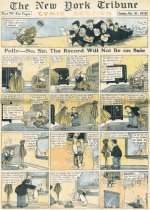The first US newspaper comic strips appeared in the late 19th century, closely allied with the invention of the color press. Jimmy Swinnerton's The Little Bears introduced sequential art and recurring characters in William Randolph Hearst's San Francisco Examiner. In the United States, the popularity of color comic strips sprang from the newspaper war between Hearst and Joseph Pulitzer. Some newspapers, such as Grit, published Sunday strips in black-and-white, and some (mostly in Canada) print their Sunday strips on Saturday.
Subject matter and genres have ranged from adventure, detective and humor strips to dramatic strips with soap opera situations, such as Mary Worth. A continuity strip employs a narrative in an ongoing storyline. Other strips offer a gag complete in a single episode, such as Little Iodine and Mutt and Jeff. The Sunday strip is contrasted with the daily comic strip, published Monday through Saturday, usually in black and white. Many comic strips appear both daily and Sunday, in some cases, as with Little Orphan Annie, telling the same story daily and Sunday, in other cases, as with The Phantom, telling one story in the daily and a different story in the Sunday. Some strips, such as Prince Valiant appear only on Sunday. Others, such as Rip Kirby, are daily only and have never appeared on Sunday. In some cases, such as Buz Sawyer, the Sunday strip is a spin-off, focusing on different characters than the daily.
An example of an action-adventure strip is The Phantom (May 28, 1939). With Ray Moore art, this was the first Phantom Sunday strip.
Famous full-page Sunday strips include Alley Oop, Barney Google and Snuffy Smith, Blondie, Bringing Up Father, Buck Rogers, Captain Easy, Flash Gordon, and Thimble Theatre. Such classics have found a new home in book collections of recent years. On the other hand, numerous strips such as Bob Gustafson's Specs and Virgil Partch's The Captain's Gig are almost completely forgotten today, other than a brief display in the Stripper's Guide site run by comics historian Allan Holtz.
Many of the leading cartoonists also drew an accompanying topper strip to run above or below their main strip, a practice which began to fade away during the late 1930s. Holtz notes, "You'll hear historians say that the topper strip was a victim of World War II paper shortages. Don't believe a word of it—it's the ads that killed full-page strips, and that killed the topper. World War II only exacerbated an already bad situation." (source:wikipedia) |



